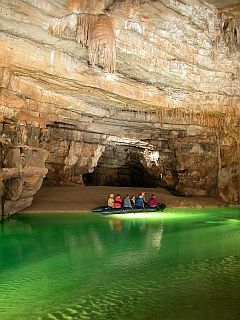
Slovenia is known as a land of caves. Its porous limestone terrain has created a belowground world that makes the country a haven for speleologists from around the world. Even so, the Križna Cave in the inner Carniola province has something that makes it special: an abundance of water. It contains no fewer than 22 lakes and just as many smaller pools.
Historians don’t know exactly when the cave, which extends for eight kilometers beneath the Bloke Plateau, was discovered. But inscriptions dating back to the 16t century indicate that the cave, named after the nearby church of the Holy Cross (Sveti Križ in Slovenian), had long been known to people from nearby villages. Records show that the first organized expeditions entered the cave in the 19th century, even though the cave’s many pools were not fully explored until the 1920s.
The speleologists who entered the cave’s depths discovered a remarkable underground world, made up of several caverns, muddy tunnels, and 45 bodies of water, including 22 full-sized underground lakes. Over the millennia, limestone deposits created natural barriers that led to the formation of distinctive underground pools.
The emerald lakes and the abundant life in them make the Križna Cave a unique attraction in Slovenia – and the best-preserved cave ecosystem in all of Europe. Several snails, beetles, and worms are among the several dozen species that reside in the cave. In fact, two species – a beetle and a water snail – have been named after the cave.
In order to preserve this delicate natural environment, the authorities have been determined to minimize human impact on the cave. Unlike many other Slovenian caves, the Križna Cave was never equipped with fixed lighting or artificial footpaths. Only a handful of visitors are allowed to visit the cave; they are equipped with special gear and flashlights. The guided tours take from one to seven hours; the longer tours allow visitors to see most of the lakes first-hand.
But Križna Jama is not just about the lakes. The world’s largest cave bear skull was found in its depths. It also contains several passageways, one of which is submerged, forming what speleologists call a sump. On the other side of the submerge passage is the New Križna Cave – another spectacular underground world, parts of which are as mysterious as Križna Cave used to be many decades ago.

































































